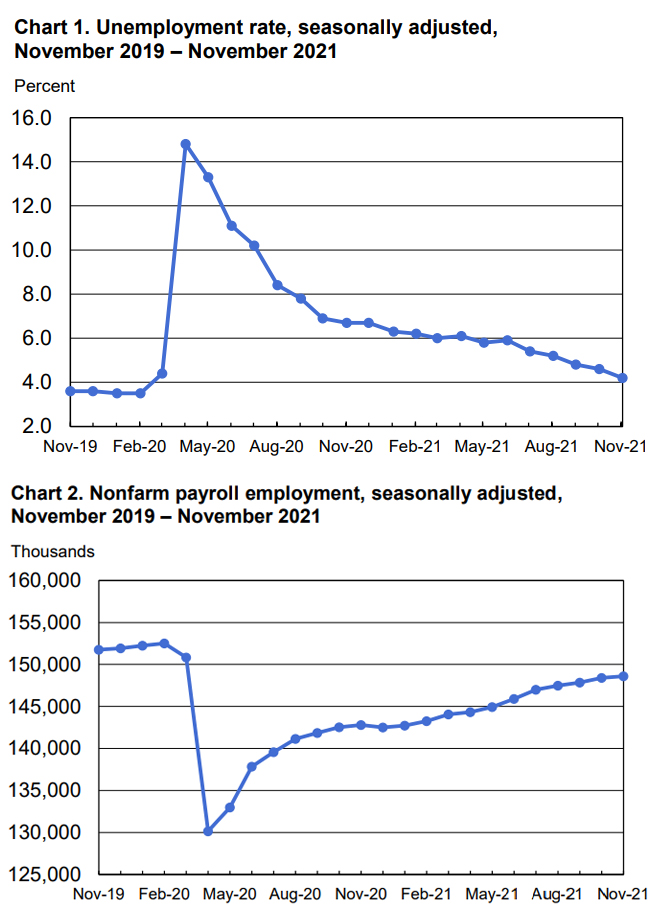|
Employment Summary for November 2021
Economic fundamentals remained positive in November and were reflected in today’s U.S. Bureau of Labor Statistics (BLS) survey. The U.S. added 210,000 jobs in November, below analysts’ expectations and below the monthly job growth average of 555,000 so far this year. Notable job gains occurred in professional and business services, transportation and warehousing, construction, and manufacturing. The unemployment rate declined by 0.4 percentage point to 4.2 percent in November.
While the Omicron variant threatens to slow future momentum, strong consumer demand and a labor force that remains smaller than before the pandemic should drive continued hiring gains in upcoming months. The labor force participation rate edged up to 61.8 percent in November but still is 1.5 percentage points lower than in February 2020.
The percent of nonfarm workers reporting that they teleworked at some point in the past four weeks continued to decrease. In November, 11.3 percent reported teleworking versus 11.6 percent in October and 13.2 percent in September.
“The BLS Data continues to inform us of solid job growth. Our MRINetwork of over 300 search firms and more than 1500 recruitment professionals provide real-time confirmation of a strong hiring environment as they continue to see record growth in assignments to place executive, technical, professional and managerial talent with their clients in every sector of the economy,” said Bert Miller, President and CEO of MRI.
“I have been fortunate to work and recruit in the consumer space for over 30 years and have seen many incredible things over that time, but nothing like the challenges and opportunities the consumer market and virtually every industry is seeing within the 2021 economy. Supply chain challenges, technology impacting every touch point, skilled labor shortages, accelerating work-from-anywhere models, and an economy roaring back from a covid induced shutdown are all driving talent demand. In this environment, we continue to counsel clients to look beyond short-term talent needs and consistently market their hiring brand, culture, and core values to attract the best talent,” noted Miller.
Taking a macro view of the employment marketplace, James Knightley, chief international economist at ING in New York commented, “There is clearly massive demand out there for workers. The bigger issue is the supply to meet that demand. If supply doesn’t show any meaningful increase, that would suggest we are going to be in a situation where the labor market is going to continue to add to upside inflationary pressures.”
Intelligence chief industry economist Carl J. Riccadonna observed the difference in job growth by education level, “The jobs deficit relative to February 2020, which currently stands at 3.9 million jobs, is entirely comprised of workers who lack a college degree. College-educated workers are now about 2% above their February 2020 employment levels and continue to see the strongest job growth, with high-school-educated workers still about 5% below pre-pandemic levels. Employment among workers with less than a high-school diploma actually declined over the last three months.”
Professional and business services added 90,000 jobs in November. Job gains continued in administrative and waste services (+42,000), and in management and technical consulting services (+12,000) as well as in computer system design and related services (+10,000).
Employment in transportation and warehousing increased by 50,000 in November and is 210,000 above its February 2020 level. Job gains occurred in couriers and messengers (+27,000) and in warehousing and storage (+9,000).
Construction employment rose by 31,000 in November, following gains of a similar magnitude in the prior 2 months. In November, employment continued to trend up in specialty trade contractors (+13,000), construction of buildings (+10,000), and heavy and civil engineering construction (+8,000).
Manufacturing added 31,000 jobs in November. Job gains occurred in miscellaneous durable goods manufacturing (+10,000) and fabricated metal products (+8,000), while motor vehicles and parts lost jobs (-10,000).
Employment in financial activities continued to trend up in November (+13,000) and is 30,000 above its pre-pandemic February 2020 level.
Job growth was little changed in leisure and hospitality following large gains earlier in the year. Also, little change was noted in healthcare employment, wholesale trade, information, and other services. Employment in retail trade declined by 20,000 in November.
“One aspect of the 2021 world of work has remained constant — the importance of compensation. We all have heard about the ‘great resignation.’ Yes, talented players are resigning, and they are also landing new gigs at the same time. It seems to be more a redistribution of talent, let’s call it a reshuffling. That reshuffle is now bringing about higher compensation, sign-on bonuses, and other long-term incentives. Yes, people are seeking roles with value driven companies, firms with a vision and purpose — and with firms that pay really well. It is still about the money — it is just now, the money must come with additional values of corporate culture, vision, and purpose. Talent today has a great many choices,” said Miller.
|
December 2021

950 Encore Way, Suite 101
Naples, FL 34110
www.www.morisey-dart.com



- The full Bureau of Labor Statistics report can be downloaded here:

|